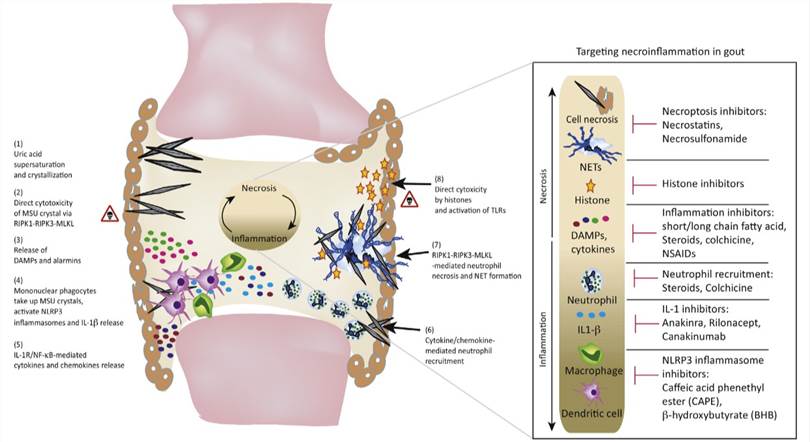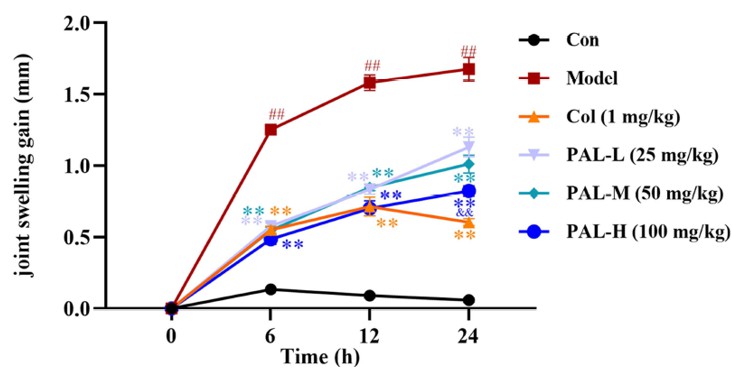- You are here: Home
- Disease Models
- Inflammation & Autoimmune Disease Models
- Gouty Arthritis Model
Disease Models
- Oncology Models
-
Inflammation & Autoimmune Disease Models
- Rheumatoid Arthritis Models
- Glomerulonephritis Models
- Multiple Sclerosis (MS) Models
- Ocular Inflammation Models
- Sjögren's Syndrome Model
- LPS-induced Acute Lung Injury Model
- Peritonitis Models
- Passive Cutaneous Anaphylaxis Model
- Delayed-Type Hypersensitivity (DTH) Models
- Inflammatory Bowel Disease Models
- Systemic Lupus Erythematosus Animal Models
- Asthma Model
- Sepsis Model
- Psoriasis Model
- Atopic Dermatitis (AD) Model
- Scleroderma Model
- Gouty Arthritis Model
- Carrageenan-Induced Air Pouch Synovitis Model
- Carrageenan-Induced Paw Edema Model
- Experimental Autoimmune Myasthenia Gravis (EAMG) Model
-
Cardiovascular Disease Models
- Surgical Models
- Animal Models of Hypertension
- Venous Thrombosis Model
- Atherosclerosis model
- Cardiac Arrhythmia Model
- Hyperlipoidemia Model
- Doxorubicin-induced Heart Failure Model
- Isoproterenol-induced Heart Failure Model
- Arterial Thrombosis Model
- Pulmonary Arterial Hypertension (PAH) Models
- Heart Failure with Preserved Ejection Fraction (HFpEF) Model
-
Neurological Disease Models
- Alzheimer's Disease Modeling and Assays
- Seizure Models
- Parkinson's Disease Models
- Ischemic Stroke Models
- Acute Spinal Cord Injury (ASCI) Model
- Traumatic Brain Injury (TBI) Model
- Hypoxic-Ischemic Encephalopathy (HIE) Model
- Tourette Syndrome (TS) Model
- Amyotrophic Lateral Sclerosis (ALS) Model
- Huntington's Disease (HD) Model
- Intracerebral hemorrhage (ICH) Models
- Pain Models
- Metabolic Disease Models
- Liver Disease Models
- Rare Disease Models
- Respiratory Disease Models
- Digestive Disease Models
-
Urology Disease Models
- Cisplatin-induced Nephrotoxicity Model
- Unilateral Ureteral Obstruction Model
- 5/6 Nephrectomy Model
- Renal Ischemia-Reperfusion Injury (RIRI) Model
- Diabetic Nephropathy (DN) Models
- Passive Heymann Nephritis (PHN) Model
- Adenine-Induced Chronic Kidney Disease (CKD) Model
- Kidney Stone Model
- Doxorubicin-Induced Nephropathy Model
- Orthopedic Disease Models
- Ocular Disease Models
- Skin Disease Models
- Infectious Disease Models
Gouty Arthritis Model
Creative Bioarray has extensive experience in conducting research on gouty arthritis. Our dedicated team will collaborate closely with you throughout the process, from selecting appropriate models to designing study plans and conducting final data analysis and reporting. We offer comprehensive preclinical animal testing services for gouty arthritis to clients worldwide, including the development of validated animal models, assessment of drug candidates' toxicity and efficacy in rodents, and more.
The most frequently occurring inflammatory arthritis is gout arthritis a condition that is rooted in hyperuricemia, which refers to an abnormally high level of uric acid in the blood. Hyperuricemia is defined by the elevated concentration of serum uric acid, and when this level surpasses a certain threshold, it can lead to the development of gout. At a temperature of 37 °C and a pH level of 7, the saturation point for serum uric acid (SUA) stands at approximately 6.8 mg/dL. Once the SUA level exceeds this saturation point, inflammatory monosodium urate (MSU) crystals begin to form within the synovium and joints. It is these MSU crystals that trigger acute gouty arthritis, causing inflammation and the characteristic symptoms of gout such as severe joint pain, swelling, and redness.
MSU crystals directly cause cytotoxic damage to epithelial cells, activating necroptosis via RIPK-1, RIPK-3, and MLKL, leading to cell membrane disruption and cell death. This prompts the release of DAMPs and alarmins, indicating cellular damage. Mononuclear phagocytes then engulf MSU crystals, activating the NLRP3 inflammasome and interleukin-1β, resulting in the secretion of proinflammatory mediators. These mediators recruit neutrophils to the site, which upon encountering MSU crystals, undergo necroptosis and NET formation. The necrotic neutrophils and NETs release additional proinflammatory mediators, such as lytic proteases and cytotoxic histones, fueling a necroinflammatory loop that intensifies inflammatory activity.
 Fig. 1 Necroinflammation in acute gouty arthritis
Fig. 1 Necroinflammation in acute gouty arthritis
Our Gouty Arthritis Model
- Available Animal
Rat
Mouse
Rabbit - Modeling Method
Monosodium urate (MSU) or saline will be injected into the ankles of the animals to induce gouty arthritis model. - Endpoints
- Paw thickness
- Paw swelling
- Paw morphology
- Body weight
- Cytokine analysis
- H&E staining
- Other customized endpoints: available upon request.
Example Data
 Fig. 2 Joint swelling gain at different time points
Fig. 2 Joint swelling gain at different time points
 Fig. 3 Hematoxylin and eosin staining of leukocytes in joint tissues (black arrow)
Fig. 3 Hematoxylin and eosin staining of leukocytes in joint tissues (black arrow)
Quotation and Ordering
Creative Bioarray, a top CRO partner, has developed a wide range of inflammation and autoimmune disease models. These models are instrumental in enabling our clients to delve into the mechanisms of various diseases and evaluate the potential efficacy of their drug candidates. If you are interested in our services, please feel free to contact us at any time or submit an inquiry to us directly.
References
- Cheng, J.J., et al. Palmatine protects against MSU-induced gouty arthritis via regulating the NF-κB/NLRP3 and Nrf2 pathways. Drug Design, Development and Therapy, 2023: 2119-2132.
- Desai, J., et al. Molecular pathophysiology of gout. Trends in molecular medicine, 2017, 23(8): 756-768.
- Patil, T., et al. A brief review on in vivo models for Gouty Arthritis. Metabolism Open, 2021, 11: 100100.
For research use only. Not for any other purpose.

